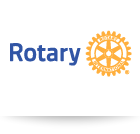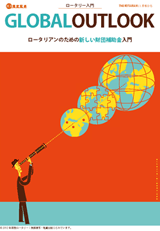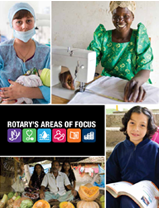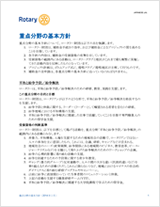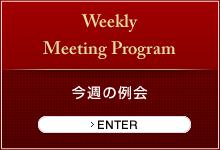The Rotary Foundation
ABOUT The Rotary Foundation
The Rotary Foundation transforms your gifts into projects that change lives both close to home and around the world. As the charitable arm of Rotary, we tap into a global network of Rotarians who invest their time, money, and expertise into our priorities, such as eradicating polio and promoting peace. Foundation grants empower Rotarians to approach challenges such as poverty, illiteracy, and malnutrition with sustainable solutions that leave a lasting impact.
Strong financial oversight, a stellar charity rating, and a unique funding model mean that we make the very most of your contribution. Give and become a part of Rotary’s life-changing work!
History of The Rotary Foundation
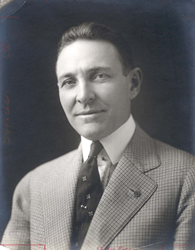 At the 1917 convention, outgoing RI President Arch C. Klumph proposed to set up an endowment “for the purpose of doing good in the world.” In 1928, it was renamed The Rotary Foundation, and it became a distinct entity within Rotary International.
At the 1917 convention, outgoing RI President Arch C. Klumph proposed to set up an endowment “for the purpose of doing good in the world.” In 1928, it was renamed The Rotary Foundation, and it became a distinct entity within Rotary International.
Growth of the Foundation
In 1929, the Foundation made its first gift of $500 to the International Society for Crippled Children. The organization, created by Rotarian Edgar F. “Daddy” Allen, later grew into Easter Seals.
When Rotary founder Paul Harris died in 1947, contributions began pouring in to Rotary International, and the Paul Harris Memorial Fund was created to build the Foundation.
Evolution of Foundation programs
1947: The Foundation established its first program, Fellowships for Advance Study, later known as Ambassadorial Scholarships.
1965-66: Three programs were launched: Group Study Exchange, Awards for Technical Training, and Grants for Activities in Keeping with the Objective of The Rotary Foundation, which was later called Matching Grants.
1978: Rotary introduced the Health, Hunger and Humanity (3-H) Grants. The first 3-H Grant funded a project to immunize 6 million Philippine children against polio.
1985: The PolioPlus program was launched to eradicate polio worldwide.
1987-88: The first peace forums were held, leading to Rotary Peace Fellowships.
2013: New district, global, and packaged grants enable Rotarians around the world to respond to the world’s greatest needs.
Since the first donation of $26.50 in 1917, the Foundation has received contributions totaling more than $1 billion.
Rotary Grants
District grants
District grants fund smaller, short-term activities that address needs in your community and communities worldwide. Each Rotary district gets to choose which projects it will fund with these grants.
Global grants
Global grants support large international activities that have sustainable, measurable outcomes in one or more of our areas of focus. Rotarians create their own projects and carry them out. We accept and review applications as they arrive.
Packaged grants
Packaged grants are designed by Rotary and our strategic partners. They fund activities that are similar to those for global grants, but the work of designing the activity’s general framework has already been done.
Areas of focus
We have identified specific causes to target to maximize our local and global impact. At the same time, we understand that each community has its own unique needs and concerns.
Through global grants and other resources, we help clubs focus their service efforts in the following areas.
・Promoting peace
・Fighting disease
・Providing clean water
・Saving mothers and children
・Supporting education
・Growing local economies
Promoting peace
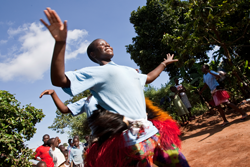 Today, 42 million people are displaced by armed conflict or persecution. Through our partnerships with several leading universities, Rotary Peace Fellows develop the skills to strengthen peace efforts, train local leaders to prevent and mediate conflict, and support long-term peace building in areas affected by conflict. We provide up to 100 peace fellowships per year at Rotary Peace Centers.
Today, 42 million people are displaced by armed conflict or persecution. Through our partnerships with several leading universities, Rotary Peace Fellows develop the skills to strengthen peace efforts, train local leaders to prevent and mediate conflict, and support long-term peace building in areas affected by conflict. We provide up to 100 peace fellowships per year at Rotary Peace Centers.
Fighting disease
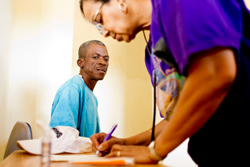 More than 100 million people are pushed into poverty each year because of medical costs. We aim to improve and expand access to low-cost and free health care in underdeveloped areas. Our members educate and mobilize communities to help prevent the spread of major diseases such as polio, HIV/AIDS, and malaria.
More than 100 million people are pushed into poverty each year because of medical costs. We aim to improve and expand access to low-cost and free health care in underdeveloped areas. Our members educate and mobilize communities to help prevent the spread of major diseases such as polio, HIV/AIDS, and malaria.
Many of our projects ensure that medical training facilities are located where the workforce lives.
Providing clean water
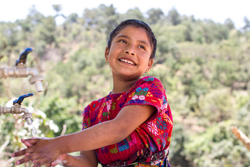 More than 2.5 billion people lack access to adequate sanitation facilities. At least 3,000 children die each day from diarrheal diseases caused by unsafe water. Our projects give communities the ability to develop and maintain sustainable water and sanitation systems and support studies related to water and sanitation.
More than 2.5 billion people lack access to adequate sanitation facilities. At least 3,000 children die each day from diarrheal diseases caused by unsafe water. Our projects give communities the ability to develop and maintain sustainable water and sanitation systems and support studies related to water and sanitation.
Saving mothers and children
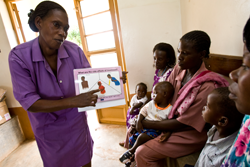 At least 7 million children under the age of five die each year due to malnutrition, poor health care, and inadequate sanitation. To help reduce this rate, we provide immunizations and antibiotics to babies, improve access to essential medical services, and support trained health care providers for mothers and their children. Our projects ensure sustainability by empowering the local community to take ownership of health care training programs.
At least 7 million children under the age of five die each year due to malnutrition, poor health care, and inadequate sanitation. To help reduce this rate, we provide immunizations and antibiotics to babies, improve access to essential medical services, and support trained health care providers for mothers and their children. Our projects ensure sustainability by empowering the local community to take ownership of health care training programs.
Supporting education
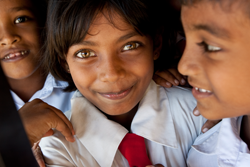 Sixty-seven million children worldwide have no access to education and more than 775 million people over the age of 15 are illiterate. Our goal is to strengthen the capacity of communities to support basic education and literacy, reduce gender disparity in education, and increase adult literacy.
Sixty-seven million children worldwide have no access to education and more than 775 million people over the age of 15 are illiterate. Our goal is to strengthen the capacity of communities to support basic education and literacy, reduce gender disparity in education, and increase adult literacy.
Growing local economies
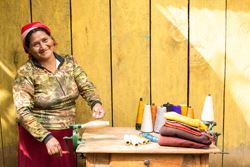 Nearly 1.4 billion employed people live on less than $1.25 a day. We carry out service projects that enhance economic and community development and develop opportunities for decent and productive work for young and old. We also help strengthen local entrepreneurs and community leaders, particularly women, in impoverished communities.
Nearly 1.4 billion employed people live on less than $1.25 a day. We carry out service projects that enhance economic and community development and develop opportunities for decent and productive work for young and old. We also help strengthen local entrepreneurs and community leaders, particularly women, in impoverished communities.
